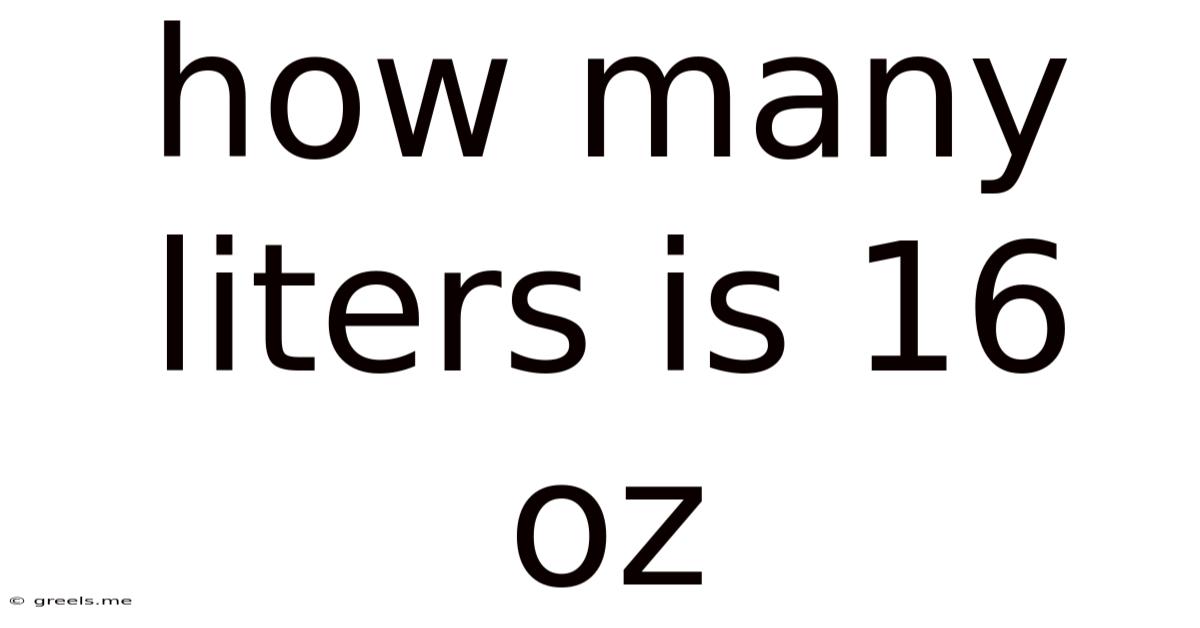How Many Liters Is 16 Oz
Greels
May 19, 2025 · 4 min read

Table of Contents
How Many Liters is 16 oz? A Comprehensive Guide to Fluid Conversions
Understanding fluid volume conversions is crucial in various aspects of life, from cooking and baking to scientific experiments and international trade. One common conversion that often causes confusion is determining how many liters are in 16 ounces. This comprehensive guide will not only answer that question but also delve deeper into the intricacies of fluid volume measurements, offering practical tips and tricks to master these conversions.
Understanding the Units:
Before diving into the conversion, let's clarify the units involved:
-
Ounces (oz): A unit of volume primarily used in the United States and some other countries. It's important to note that there are different types of ounces: fluid ounces (fl oz) used for liquid volume, and avoirdupois ounces used for weight. This article focuses on fluid ounces (fl oz).
-
Liters (L): The metric unit of volume, widely used internationally. One liter is equivalent to 1 cubic decimeter (dm³).
The Conversion: 16 fl oz to Liters
The basic conversion factor is: 1 fluid ounce (fl oz) ≈ 0.02957 liters (L)
Therefore, to find out how many liters are in 16 fluid ounces, we simply multiply:
16 fl oz * 0.02957 L/fl oz ≈ 0.473 liters
So, 16 fluid ounces is approximately equal to 0.473 liters.
Why "Approximately"?
The conversion isn't perfectly precise because different standards and measurement systems have slightly varying definitions. However, 0.473 liters is an accurate enough approximation for most everyday purposes.
Practical Applications:
Understanding this conversion is valuable in many scenarios:
-
Cooking and Baking: Recipes often use different units of measurement. Converting between ounces and liters is essential for accurate ingredient proportions. For instance, if a recipe calls for 16 fl oz of milk, you'll know that this is roughly equivalent to 0.473 liters.
-
Travel: When traveling internationally, you might need to convert fluid ounces to liters to understand the liquid restrictions for carry-on luggage on airplanes.
-
Science and Research: Accurate fluid measurements are critical in scientific experiments and research. Converting between different units ensures consistent and reliable results.
-
International Trade: Many products have their volumes listed in both US customary units (ounces, etc.) and metric units (liters, etc.) for global distribution.
Beyond the Basics: Further Exploration of Fluid Volume Conversions
Mastering the conversion between fluid ounces and liters opens the door to understanding a broader range of fluid volume conversions. Let's explore some related conversions:
1. Converting Liters to Fluid Ounces:
To convert liters to fluid ounces, use the reciprocal of the previous conversion factor:
1 L ≈ 33.814 fl oz
2. Converting Other Units:
Many other units are used to measure fluid volume, including:
- Milliliters (mL): 1 liter = 1000 milliliters. Therefore, 16 fl oz ≈ 473 mL.
- Gallons (gal): 1 US gallon ≈ 128 fl oz. You can use this to easily convert between gallons and liters.
- Pints (pt) and Cups (c): 1 US pint = 16 fl oz, and 1 US cup = 8 fl oz. This allows for easy conversions between ounces, pints, and cups.
3. Using Online Conversion Tools:
Numerous online conversion tools are available to simplify the process. These tools often offer conversions between a wide range of units, making them a handy resource. However, always double-check the results, especially in critical applications.
Tips and Tricks for Accurate Conversions:
-
Use a Calculator: For precise conversions, it's always best to use a calculator, particularly when dealing with complex conversions involving multiple units.
-
Round Appropriately: Depending on the context, rounding to a suitable number of decimal places can simplify the result without sacrificing accuracy. For example, rounding 0.473 liters to 0.5 liters is acceptable for many purposes.
-
Understand Significant Figures: In scientific and engineering contexts, pay close attention to significant figures to ensure accuracy and avoid errors.
-
Double-Check Your Work: Always double-check your calculations to minimize errors and ensure accuracy.
Frequently Asked Questions (FAQs):
-
Is 16 fl oz exactly 0.473 liters? No, it's an approximation. The exact conversion depends on the specific definitions and standards used.
-
What is the difference between fluid ounces and avoirdupois ounces? Fluid ounces measure liquid volume, while avoirdupois ounces measure weight. They are not interchangeable.
-
Where can I find a reliable online conversion tool? Many websites and applications offer free online conversion tools. However, it's always prudent to compare results from different sources.
-
Why is it important to understand fluid volume conversions? Accurate fluid measurements are essential in various fields, including cooking, baking, science, medicine, and international trade.
-
Can I use this information for medical applications? While this information is generally accurate for most applications, it's vital to use precise and verified measurement tools and techniques for medical purposes. Consult with medical professionals for any medical-related conversions.
Conclusion:
Converting 16 fluid ounces to liters is a relatively straightforward calculation, with the approximate result being 0.473 liters. However, understanding the underlying principles and the nuances of different measurement systems is crucial for accurate and reliable conversions. By mastering these concepts and using the tips and tricks outlined in this guide, you can confidently navigate fluid volume conversions in various contexts, from everyday life to scientific endeavors. Remember to always double-check your work and use the appropriate tools for precision where needed. This knowledge will enhance your understanding of measurements and improve your accuracy in countless situations.
Latest Posts
Related Post
Thank you for visiting our website which covers about How Many Liters Is 16 Oz . We hope the information provided has been useful to you. Feel free to contact us if you have any questions or need further assistance. See you next time and don't miss to bookmark.